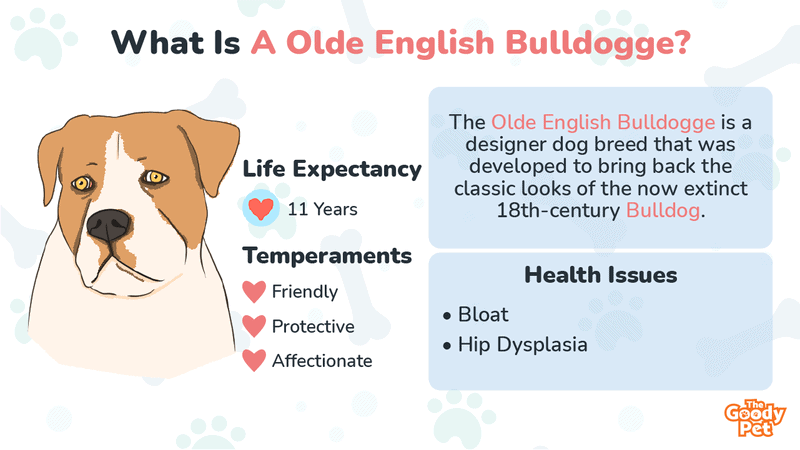I recently bumped into someone who had one of the most attractive dogs I’ve ever come across. This dog reminded me of the classic bulldogs of yore, which have since gone extinct. The dog I am talking about is the Olde English Bulldogge. So, what is an Olde English Bulldogge?
The Olde English Bulldogge is a designer dog breed that was developed to bring back the classic looks of the now-extinct 18th-century Bulldog. The breed was also developed with the hope of eliminating the health problems that plague the English Bulldog, which is very popular today.
If you’re interested in owning the Olde English Bulldogge, this article is for you. The article will cover all you need to know about this classic breed, including their expected lifespan, how to take care of an Olde English Bulldogge, their grooming requirements, as well as their temperament. To start off, let’s look at the pedigree of the Olde English Bulldogge.
Is An Old English Bulldog A Pedigree?
Despite being a classic breed, the Olde English Bulldogge is not a pedigree.
This is because the Olde English Bulldogge, sometimes referred to as the Leavitt Bulldogge is not a purebred. It is a mix of several breeds. As a result, this breed is not recognized by the American Kennel Club.
What Breeds Make An Olde English Bulldogge?
The Olde English Bulldogge was developed by crossbreeding the English Bulldog, the American Pit Bull Terrier, the American Bulldog, and the Bullmastiff.
By crossbreeding these breeds, David Leavitt, who developed the Olde English Bulldog, wanted to create a dog breed with the appearance and health of the 18th-century Bulldog and the temperament of today’s English Bulldog.
Are Olde English Bulldogges Good Family Dogs?
Despite having been developed to resemble the 18th-century Bulldogs, which were bred for dog fighting and bull baiting, the Olde English Bulldogge is a loving dog that is a good fit for families, in terms of its calm temperament among people and low level of maintenance.
This dog is also a good fit for those living in apartments.
At What Age Is An Olde English Bulldogge Fully Grown?
An Olde English Bulldogge will typically reach their maximum height within their first year. However, they will still continue increasing their weight and getting fuller in the chest area until they get to about two years old.
Can Olde English Bulldogges Give Birth Naturally?
Yes, unlike modern English Bulldogs, which can only give birth via C-section, Olde English Bulldogges are capable of giving birth naturally without any complications. In addition, they can also conceive naturally, without the need for artificial insemination.
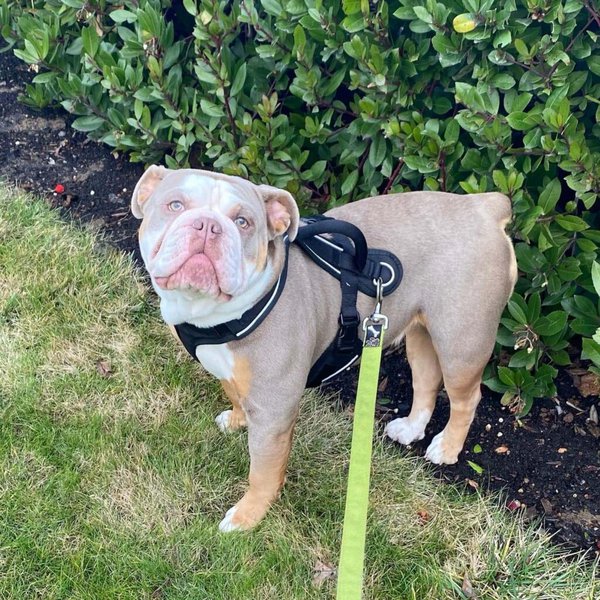
How Long Does An Olde English Bulldog Live?
The life expectancy of the Olde English Bulldog is about 11 years on average. Being a mix of multiple breeds, Olde English Bulldogges are healthier than modern English Bulldogs.
Despite being generally healthier and sturdier, however, the Olde English Bulldogge can still be affected by some health issues. Such health issues that the Olde English Bulldogge is commonly susceptible to will include:
Hip Dysplasia
When developing the Olde English Bulldogge, David Leavitt tried to breed out hip dysplasia, a genetic condition that is very common among modern English Bulldogs. However, due to the failure of some breeders to follow the proper breeding procedures and standards, the Olde English Bulldogge is still susceptible to hip dysplasia.
Hip dysplasia is a condition that results in a malformed hip joint that causes pain during movement. Some symptoms of hip dysplasia include decreased activity, limping, loss of muscle mass in the thighs, and even lameness.
The best way to avoid having to deal with this problem is to make sure that the parents of your Olde English Bulldogge pup were screened for hip dysplasia before being bred.
Bloat
Bloat, also known as gastric dilatation and volvulus, is a potentially fatal condition that is caused by a dog’s stomach filled with gas. This, in itself, is not life-threatening.
Sometimes, however, the gas-filled stomach turns upon itself, blocking both the entrance and exit to the stomach, as well as blood flow to the intestines. Once this happens, it can quickly result in death if the dog doesn’t receive prompt medical attention.
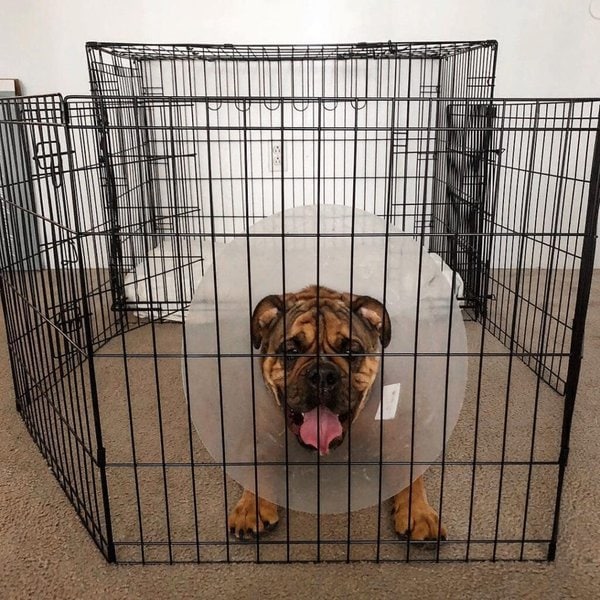
How To Take Care Of Olde English Bulldogges?
Diet Requirements
Olde English Bulldogges are more active than modern English Bulldogs, and therefore, they have greater energy requirements. A serving size of 1.5 to 2 cups of food, twice a day, is recommended. This also means you need to feed them with high-quality food that is packed with nutrients.
So, what is the best food for the Olde English Bulldogge? We recommend feeding your Olde English Bulldogge with Barkin’ Beef from Pet Plate. Pet Plate’s Barkin’ Beef is rich in nutrients and is prepared in a USDA-approved kitchen with ingredients that are safe for human consumption.
To enhance your doggie’s health and wellness, you should supplement their diet with multivitamins. It is also advisable to invest in dental water additives for your dog’s oral hygiene. Using dental water additives helps with the cleaning of your fido’s teeth and prevents plaque from building up, while at the same time keeping bad breath at bay.
Exercise Requirements
The Olde English Bulldogge is strong and athletic, just like the 18th-century Bulldog it takes after. Therefore, its physical requirements are greater than those of the modern English Bulldog. So, how much exercise does an Olde English Bulldog need?
The Olde English Bulldogge will do about one hour of physical activity every day. This should be broken into two sessions. For instance, you can take your Olde English Bulldogge for a walk in the morning, then allow them to run around the yard later in the day.
While the Olde English Bulldogge doesn’t have the respiratory problems of the modern English Bulldog, they are still sensitive to extreme temperatures, and should not exercise when it’s too hot or too cold.
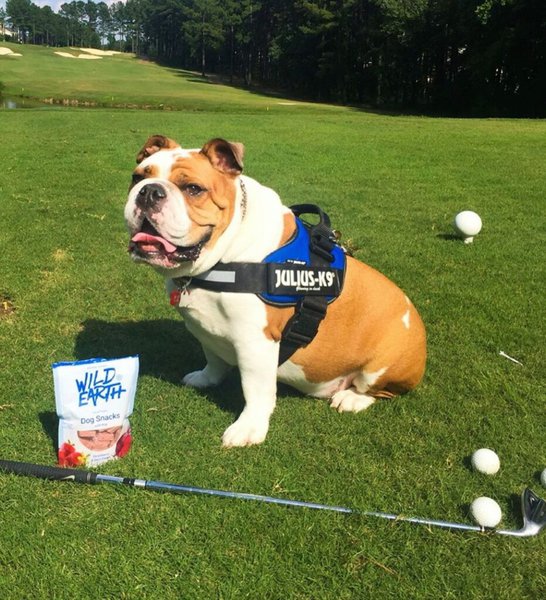
Are Olde English Bulldogges Easy To Train? Temperaments Of Olde English Bulldogges
The Olde English Bulldogge is intelligent and eager to please, which makes it a very easy dog to train. During the training, however, you have to have to be firm and confident. You want your pooch to see you as the pack leader; otherwise, the Olde English Bulldogge will become stubborn.
It is also important to only use positive reinforcement during training. Negative training methods, such as punishment, will only damage the relationship between you and your canine buddy, without making the training more effective.
Temperament
The Olde English Bulldogge is a friendly and affectionate pooch that will enjoy following you around and spending time with you. They form strong bonds with their owners and are very good family dogs.
While they are friendly and affectionate, Olde English Bulldogges can also be very protective. They are fearless and will not be afraid to step up and confront anyone that seems to be a threat to the people they love. This makes them good guard dogs.
Are Olde English Bulldogges Aggressive?
Despite being developed to take after a breed that was bred for its aggression, the Olde English Bulldogge is not an aggressive dog. However, some Olde English Bulldogges will have trouble getting along with other dogs of the same sex.
Are Olde English Bulldogges Good With Cats?
Olde English Bulldogges will sometimes have a high prey drive, which means that they’ll not get along well with small pets like cats, rabbits, and hamsters. However, this can be tamed through early and proper socialization.
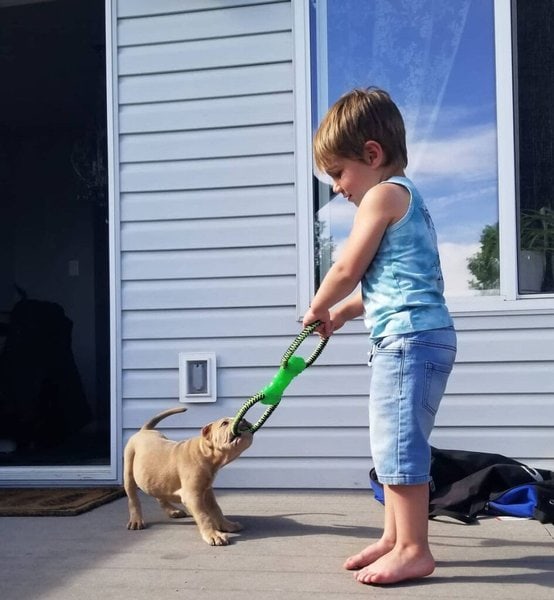
Do Olde English Bulldogs Shed A Lot? Grooming Tips For Olde English Bulldogges
Are Olde English Bulldogges Hypoallergenic?
The Olde English Bulldogge has a short and tight coat that sheds moderately, and therefore, it is not suitable for people with allergies.
Brushing Requirements
Due to its short tight coat and a moderate level of shedding, the Olde English Bulldogge is not very demanding when it comes to grooming. Weekly brushing is enough to remove any loose furs on your doggie’s coat and keep it clean. However, the shedding will increase in spring and fall, in which case you’ll need to increase the brushing frequency.
Due to the short coat, you need to make sure that you’re using a proper brushing and deshedding tool that will not cause injury to your doggo’s coat. Our top recommendation is the FURminator Undercoat Tool, which is designed to make the brushing process safe for your dog and easy for you.
Bathing Requirements
The Olde English Bulldogge does not require regular baths unless your dog has been frolicking in the dirt. This is because too frequent baths can leave your furry buddy’s skin too dry and make them prone to infections. Giving your Olde English Bulldogge a bath once in three or four months should be enough.
It’s also good to note that dogs have sensitive skin, and therefore, you should never give your four-legged buddy a bath using human shampoos. Instead, go for dog-specific shampoos, such as the Seamus Cherry Blossom Whitening Dog Shampoo, which is specially formulated to moisturize and nourish your doggie’s coat.
Related Questions
How Much Does An Olde English Bulldogge Cost? An Olde English Bulldogge puppy will cost you between $2,000 and $3,000 on average. Sometimes, however, the price can go as high as $8,500. The price will depend on factors like the reputation of the breeder, the pup’s bloodline, whether they have been trained and socialized, whether they have papers, and so on.
What Is The Difference Between An Olde English Bulldog And An English Bulldog? The Olde English Bulldogge is generally larger and more athletic compared to the modern English Bulldog. In addition, the face of the Olde English Bulldogge is less wrinkled than that of the modern English Bulldog, and they don’t have the respiratory problems that plague the modern English Bulldog.
What Is An F1 Olde English Bulldogge? An F1 Olde English Bulldogge is a cross between a generational (purebred) Olde English Bulldogge and another breed, such as a Bullmastiff, an English Bulldog, an American Pit Bull Terrier, or the American Bulldog. While an F1 Olde English Bulldogge contains the genes of the breeds that make the Olde English Bulldogge, it is not considered to be a purebred English Bulldogge.

